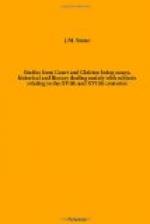A few more miserable years of petty intrigues, it being no longer in her power to carry on important ones, and Margaret came to the close of her faithless, undignified life. But before the end, a ray of sorrow for her mis-spent days brightened the hitherto unrelieved gloom of her career. Henry’s messenger, sent after her death to gather up the details of her last moments, and above all, to find out whether she had made a will, wrote to the king as follows:—
“When she did perceive that death did approach, she did desire the friars that was her confessors, that they should sit on their knees before the King, and to beseech him that he would be good and gracious unto the Earl of Angwische, and did extremely lament and ask God mercy that she had offended unto the said Earl as she had.”
The friars were also to plead with her son for the Lady Margaret Douglas, the daughter whom she had so remorselessly abandoned, and to beg him that she might have some of her mother’s goods. And thus, making what reparation she could, with penitent words on her lips, Margaret Tudor passed away.
II. NOR WIFE NOR WIDOW
The history of the first two marriages of Henry VIII. is of such vital importance, affecting as they did the whole course of religion in England, from the first whisperings of the divorce down to the present day, that it is not to be wondered at if the royal Bluebeard’s subsequent matrimonial alliances have been considered negligible quantities. And yet, at least one of them was of extreme political, and even religious, importance, and was fraught with so much mystery that until the most recent investigations, the true inwardness of the matter has been totally misapprehended. The story of Anne of Cleves’ portrait, and Henry’s supposed disappointment when he saw the lady herself for the first time, is authentic in so far as it was exactly what the king chose to have circulated about his fourth marriage. But if it contained half the truth, it was the other half that really mattered.
After the fall of Wolsey, Thomas Cromwell had by his astute policy succeeded in bringing about a religious state of things in England that approached very nearly to Lutheranism. Taking advantage of Henry’s pique and anger at the Pope’s refusal to grant him a divorce from Katharine of Arragon, Cromwell set about widening the breach between England and Rome. After weakening the power of the bishops and lower clergy, he was able to force the oath of supremacy upon the nation, and having thus satisfied his master’s pride and vanity, his next step was by the dissolution of the monasteries to pander to Henry’s greed, while at the same time he filled his own pockets.
In pursuit of these ends he had covered the land with gibbets, and caused the noblest heads in England to fall upon the block. He had branded the king’s own daughter with the stigma of infamy, and to obtain her consent thereto had kept the axe suspended over her. He had been able to accomplish all this because thus far he had taken Henry’s measure correctly, working upon his worst passions, and suggesting ever fresh means of satisfying them. Then came a point at which his interests and those of the king diverged.




